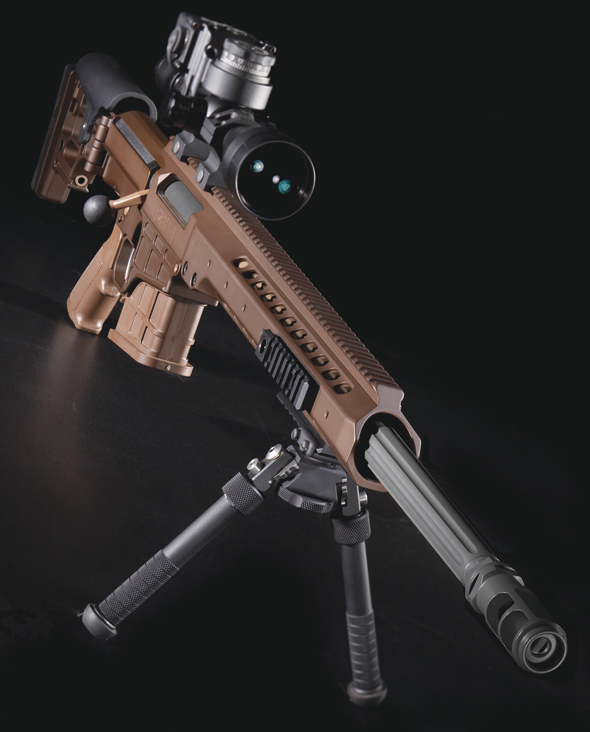At GunDigest, we independently review products. However, we may earn a commission when you purchase through links on our site. Learn More
Gun Review: Barrett MRAD

Designed for the military, the versatile Barrett MRAD rifle is finding acceptance among all long-range shooters.
Nine companies stepped up to the challenge to design their versions of the Precision Sniper Rifle when the United States Special Operations Command published Performance Specifications for the PSR back in late 2009. The Barrett MRAD – Multi-Role Adaptive Design – quickly joined the competition for the coveted government contract.
Even though the Barrett MRAD was a runner-up in the final competition, it still served as a strong performer that continues to find acceptance with serious long-range accuracy hounds, foreign militaries and domestic SWAT teams.
The Barrett MRAD was specifically designed to meet the needs of the Precision Sniper Rifle (PSR) program, which includes a set of requirements by the United States Special Operations Command (USSOCOM) that states the current system mission of the PSR is to enable USSOCOM snipers to use one or more shots to interdict enemy personnel, positions and nontechnical vehicles mounted with crew served weapons out to 1,500 meters or further, and to defeat NIJ Level III body armor out to 900 meters in its .338 Lapua Magnum configuration. Other PSR parameters encompass length, weight, magazine capacity, penetration of the projectile, the ability to mount night vision devices and other accessories.
Goal of the Barrett MRAD
To get an idea of what the Barrett MRAD is all about, a review of the USSOCOM Performance Specifications for the PSR tells the story. A PSR was specified to be no longer than 50 inches fully extended without suppressor, with the ideal set at 40 inches overall length.
With the stock folded, the maximum length is 40 inches, with 36 set as the objective of USSOCOM. The threshold weight for the weapon with a M1913 rail and a 10-round unloaded magazine is 18 pounds, and the objective weight is no greater than 13 pounds. The MRAD submitted for the PSR trial was fitted with a 24.5-inch barrel and weighed 14.8 pounds without an optic.
The MRAD submitted for the PSR was a 24.5-inch fluted version. So was the one tested for this article. Barrel lengths between 20 and 27 inches are available in .338 Lapua Magnum.
The MRAD features a monolithic chassis with a 30 MOA taper MIL STD 1913 rail that measures 21.75 inches and offers plenty of space for in-line night vision devices. Side and bottom rails allow for mounting a number of other accessories.
It includes two configurable 4-inch Picatinny rails and an 8-inch rail, all of which can be mounted along the 3, 6 and 9 o’clock surfaces on the forward part of the upper receiver. The bottom of the buttstock also has a M1913 rail for mounting a monopod.
The MRAD’s stock is foldable for enhanced portability, yet locks in as solid as a fixed-stock rifle.
When folded, the stock latches around the bolt handle for added security during transport. Made of a temperature-resistant polymer, the adjustable cheek piece also offers a consistent rifle-to-user contact point. Length of pull can be set to five different positions with the push of a single button.
One of the objectives of the PSR is caliber modularity. The .338 Lapua Magnum is one of the most widely used cartridges by militaries around the world that meet the PSR’s cartridge ballistic requirements.
Currently, the .300 Winchester Magnum is in use with all of the M24s and the M2010, which is a conversion of the M24 from .308. The military also wants to retain the ability to shoot 7.62 NATO for cost-effective training. The MRAD is offered with barrels for each caliber.
The MRAD also boasts Barrett’s new trigger module that is accessible for maintenance, adjustment and replacement. This is a match-grade trigger that is adjustable from 3 to 5 pounds of let-off. The trigger on the test gun was 3 pounds, but is adjustable from 2.5 to 5 pounds.
The MRAD’s safety is an AR-style thumb lever that can be quickly switched from left to right. For guys who like to shoot with the thumb forward instead of wrapped around the pistol grip, it’s an easy change to move the safety from one side to the other. An ambidextrous magazine release, located between the front of the trigger guard and the magazine well, drops empty magazines free while retaining the firing hand’s finger grip.
The finish on the stock is 7000 series Mil Spec 3 hard-coat anodized aluminum in Barrett Multi-Role brown. A rust preventative coats all steel components. The pistol grip is a standard A2 grip. The bolt assembly slides inside a polymer sleeve, which works well without lube.
Down-Range Performance
A few weeks later, I took yet another MRAD to my farm to punch more paper. With the 24.5-inch 7.62 NATO barrel installed, I fired a couple of match loads at 100 yards with the rifle atop an Accu-Shot Atlas bipod.
After firing 100 rounds downrange, my worst 5-shot group with either load was in the high 0.800-inch range. Federal’s 168-grain Gold Medal Match averaged 0.608, and the smallest group went 0.293-inch. Winchester’s 168-grain match load averaged 0.632, with the best group measuring 0.340-inch.
This switch-barrel outfit is sure to cover practically any precision rifle need a shooter may have. Barrett’s MRAD is a proven long-range hammer, and its popularity among military, law enforcement and sporting circles should continue to grow every day.
Editor's Note: This article appeared in the June 3, 2013 issue of Gun Digest the Magazine.
Next Step: Get your FREE Printable Target Pack
Enhance your shooting precision with our 62 MOA Targets, perfect for rifles and handguns. Crafted in collaboration with Storm Tactical for accuracy and versatility.
Subscribe to the Gun Digest email newsletter and get your downloadable target pack sent straight to your inbox. Stay updated with the latest firearms info in the industry.